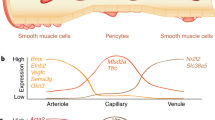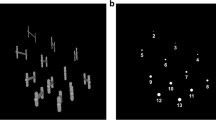Abstract
The brain vasculature can be investigated in different ways ranging from in vivo to biochemical analysis. Immunohistochemistry is a simple and powerful technique that can also be applied to archival tissues. However, staining of brain vessels on paraffin sections has been challenging. In this study, we developed an optimized method that can be used in paraffin-embedded mouse and human brain tissues derived from healthy controls and neurological disorders such as Alzheimer’s disease. We subsequently showed that this method is fully compatible with the detection of glial cells and key markers of Alzheimer’s disease including amyloid beta and phosphorylated Tau protein. Furthermore, we observed that the length of microvasculature in hippocampus of TgCRND8 Alzheimer’s disease mouse model is reduced, which is correlated with the decreased blood flow in hippocampus as determined by arterial spin labeling perfusion magnetic resonance imaging. Finally, we determined that the microvasculature length in two other Alzheimer’s disease mouse models, APP and PS1 double-transgenic mice and P301S Tau-transgenic mice, is also shortened in the dentate gyrus. Thus, we have established a new, simple and robust method to characterize the brain vasculature in the mouse and human brain.







Similar content being viewed by others
References
Asllani I, Habeck C, Scarmeas N, Borogovac A, Brown TR, Stern Y (2008) Multivariate and univariate analysis of continuous arterial spin labeling perfusion MRI in Alzheimer’s disease. J Cereb Blood Flow Metabol 28:725–736. https://doi.org/10.1038/sj.jcbfm.9600570
Attems J, Jellinger KA (2014) The overlap between vascular disease and Alzheimer’s disease—lessons from pathology. BMC Med 12:206. https://doi.org/10.1186/s12916-014-0206-2
Binnewijzend MA et al (2013) Cerebral blood flow measured with 3D pseudocontinuous arterial spin-labeling MR imaging in Alzheimer disease and mild cognitive impairment: a marker for disease severity. Radiology 267:221–230. https://doi.org/10.1148/radiol.12120928
Blair LJ et al (2015) Tau depletion prevents progressive blood-brain barrier damage in a mouse model of tauopathy. Acta Neuropathol Commun 3:8. https://doi.org/10.1186/s40478-015-0186-2
Bordeleau M, ElAli A, Rivest S (2016) Severe chronic cerebral hypoperfusion induces microglial dysfunction leading to memory loss in APPswe/PS 1 mice. Oncotarget 7:11864–11880. https://doi.org/10.18632/oncotarget.7689
Bouras C et al (2006) Stereologic analysis of microvascular morphology in the elderly: Alzheimer disease pathology and cognitive status. J Neuropathol Exp Neurol 65:235–244. https://doi.org/10.1097/01.jnen.0000203077.53080.2c
Buee L, Hof PR, Bouras C, Delacourte A, Perl DP, Morrison JH, Fillit HM (1994) Pathological alterations of the cerebral microvasculature in Alzheimer’s disease and related dementing disorders. Acta Neuropathol 87:469–480
Chishti MA et al (2001) Early-onset amyloid deposition and cognitive deficits in transgenic mice expressing a double mutant form of amyloid precursor protein 695. J Biol Chem 276:21562–21570. https://doi.org/10.1074/jbc.M100710200
Clark PJ, Brzezinska WJ, Puchalski EK, Krone DA, Rhodes JS (2009) Functional analysis of neurovascular adaptations to exercise in the dentate gyrus of young adult mice associated with cognitive gain. Hippocampus 19:937–950. https://doi.org/10.1002/hipo.20543
D’Amico F, Skarmoutsou E, Stivala F (2009) State of the art in antigen retrieval for immunohistochemistry. J Immunol Methods 341:1–18. https://doi.org/10.1016/j.jim.2008.11.007
De Strooper B, Karran E (2016) The cellular phase of Alzheimer’s. Dis Cell 164:603–615. https://doi.org/10.1016/j.cell.2015.12.056
Dobre MC, Ugurbil K, Marjanska M (2007) Determination of blood longitudinal relaxation time (T1) at high magnetic field strengths. Magn Reson Imaging 25:733–735. https://doi.org/10.1016/j.mri.2006.10.020
Dorr A et al (2012) Amyloid-beta-dependent compromise of microvascular structure and function in a model of Alzheimer’s disease. Brain 135:3039–3050. https://doi.org/10.1093/brain/aws243
Dudvarski Stankovic N, Teodorczyk M, Ploen R, Zipp F, Schmidt MH (2016) Microglia-blood vessel interactions: a double-edged sword in brain pathologies. Acta Neuropathol 131:347–363. https://doi.org/10.1007/s00401-015-1524-y
Faure A et al (2011) Impaired neurogenesis, neuronal loss, and brain functional deficits in the APPxPS1-Ki mouse model of Alzheimer’s disease. Neurobiol Aging 32:407–418. https://doi.org/10.1016/j.neurobiolaging.2009.03.009
Fischer VW, Siddiqi A, Yusufaly Y (1990) Altered angioarchitecture in selected areas of brains with Alzheimer’s disease. Acta Neuropathol 79:672–679
Franciosi S et al (2007) Pepsin pretreatment allows collagen IV immunostaining of blood vessels in adult mouse brain. J Neurosci Methods 163:76–82. https://doi.org/10.1016/j.jneumeth.2007.02.020
Fries P et al (2012) Comparison of retrospectively self-gated and prospectively triggered FLASH sequences for cine imaging of the aorta in mice at 9.4T. Investig Radiol 47:259–266. https://doi.org/10.1097/RLI.0b013e31823d3eb6
Gama Sosa MA et al (2010) Age-related vascular pathology in transgenic mice expressing presenilin 1-associated familial Alzheimer’s disease mutations. Am J Pathol 176:353–368. https://doi.org/10.2353/ajpath.2010.090482
Gama Sosa MA et al. (2014) Selective vulnerability of the cerebral vasculature to blast injury in a rat model of mild traumatic brain injury. Acta Neuropathol Commun 2:67 https://doi.org/10.1186/2051-5960-2-67
Hebert F, Grand’maison M, Ho MK, Lerch JP, Hamel E, Bedell BJ (2013) Cortical atrophy and hypoperfusion in a transgenic mouse model of Alzheimer’s disease. Neurobiol Aging 34:1644–1652. https://doi.org/10.1016/j.neurobiolaging.2012.11.022
Herscovitch P, Raichle ME (1985) What is the correct value for the brain–blood partition coefficient for water? J Cereb Blood Flow Metabol 5:65–69. https://doi.org/10.1038/jcbfm.1985.9
Huang SN, Minassian H, More JD (1976) Application of immunofluorescent staining on paraffin sections improved by trypsin digestion Laboratory investigation. J Tech Methods Pathol 35:383–390
Huang W et al (2014) Novel NG2-CreERT2 knock-in mice demonstrate heterogeneous differentiation potential of NG2 glia during development. Glia 62:896–913. https://doi.org/10.1002/glia.22648
Jucker M, Bialobok P, Hagg T, Ingram DK (1992) Laminin immunohistochemistry in brain is dependent on method of tissue fixation. Brain Res 586:166–170
Kai H, Shin RW, Ogino K, Hatsuta H, Murayama S, Kitamoto T (2012) Enhanced antigen retrieval of amyloid beta immunohistochemistry: re-evaluation of amyloid beta pathology in Alzheimer disease and its mouse model. J Histochem Cytochem 60:761–769. https://doi.org/10.1369/0022155412456379
Kim SG, Tsekos NV, Ashe J (1997) Multi-slice perfusion-based functional MRI using the FAIR technique: comparison of CBF and BOLD effects. NMR Biomed 10:191–196
Kloepper J et al (2016) Ang-2/VEGF bispecific antibody reprograms macrophages and resident microglia to anti-tumor phenotype and prolongs glioblastoma survival. Proc Natl Acad Sci USA 113:4476–4481. https://doi.org/10.1073/pnas.1525360113
Kober F et al (2007) MRI follow-up of TNF-dependent differential progression of atherosclerotic wall-thickening in mouse aortic arch from early to. advanced stages. Atherosclerosis 195:e93–e99. https://doi.org/10.1016/j.atherosclerosis.2007.06.015
Kouznetsova E et al (2006) Developmental and amyloid plaque-related changes in cerebral cortical capillaries in transgenic Tg2576 Alzheimer mice. Int J Dev Neurosci 24:187–193. https://doi.org/10.1016/j.ijdevneu.2005.11.011
Lamoke F et al (2015) Amyloid beta peptide-induced inhibition of endothelial nitric oxide production involves oxidative stress-mediated constitutive eNOS/HSP90 interaction and disruption of agonist-mediated Akt activation. J Neuroinflamm 12:84. https://doi.org/10.1186/s12974-015-0304-x
Lee GD, Aruna JH, Barrett PM, Lei DL, Ingram DK, Mouton PR (2005) Stereological analysis of microvascular parameters in a double transgenic model of Alzheimer’s disease. Brain Res Bull 65:317–322. https://doi.org/10.1016/j.brainresbull.2004.11.024
Love S, Miners JS (2016) Cerebrovascular disease in ageing and Alzheimer’s disease. Acta Neuropathol 131:645–658. https://doi.org/10.1007/s00401-015-1522-0
Massaad CA, Amin SK, Hu L, Mei Y, Klann E, Pautler RG (2010) Mitochondrial superoxide contributes to blood flow and axonal transport deficits in the Tg2576 mouse model of Alzheimer’s disease. PloS one 5:e10561 https://doi.org/10.1371/journal.pone.0010561
Mauro A, Bertolotto A, Germano I, Giaccone G, Giordana MT, Migheli A, Schiffer D (1984) Collagenase in the immunohistochemical demonstration of laminin, fibronectin and factor VIII/RAg in nervous tissue after fixation. Histochemistry 80:157–163
Montagne A, Nation DA, Pa J, Sweeney MD, Toga AW, Zlokovic BV (2016) Brain imaging of neurovascular dysfunction in Alzheimer’s disease. Acta Neuropathol 131:687–707. https://doi.org/10.1007/s00401-016-1570-0
Mori S, Sternberger NH, Herman MM, Sternberger LA (1992) Variability of laminin immunoreactivity in human autopsy brain. Histochemistry 97:237–241
Muneton-Gomez VC et al (2012) Neural differentiation of transplanted neural stem cells in a rat model of striatal lacunar infarction: light and electron microscopic observations. Front Cell Neurosci 6:30. https://doi.org/10.3389/fncel.2012.00030
Niwa K, Porter VA, Kazama K, Cornfield D, Carlson GA, Iadecola C (2001) A beta-peptides enhance vasoconstriction in cerebral circulation. Am J Physiol Heart Circ Physiol 281:H2417–H2424
Paul J, Strickland S, Melchor JP (2007) Fibrin deposition accelerates neurovascular damage and neuroinflammation in mouse models of Alzheimer’s disease. J Exp Med 204:1999–2008. https://doi.org/10.1084/jem.20070304
Poisnel G et al (2012) Increased regional cerebral glucose uptake in an APP/PS1 model of Alzheimer’s disease. Neurobiol Aging 33:1995–2005. https://doi.org/10.1016/j.neurobiolaging.2011.09.026
Radde R et al (2006) Abeta42-driven cerebral amyloidosis in transgenic mice reveals early and robust pathology. EMBO Rep 7:940–946. https://doi.org/10.1038/sj.embor.7400784
Shi SR, Key ME, Kalra KL (1991) Antigen retrieval in formalin-fixed, paraffin-embedded tissues: an enhancement method for immunohistochemical staining based on microwave oven heating of tissue sections. J Histochem Cytochem 39:741–748
Soto I et al (2015) APOE stabilization by exercise prevents aging neurovascular dysfunction and complement induction. PLoS Biol 13:e1002279. https://doi.org/10.1371/journal.pbio.1002279
Spitzer M, Wildenhain J, Rappsilber J, Tyers M (2014) BoxPlotR: a web tool for generation of box plots. Nat Methods 11:121–122. https://doi.org/10.1038/nmeth.2811
Vollert CT, Moree WJ, Gregory S, Bark SJ, Eriksen JL (2015) Formaldehyde scavengers function as novel antigen retrieval agents. Sci Rep 5:17322. https://doi.org/10.1038/srep17322
Walchli T et al (2015) Quantitative assessment of angiogenesis, perfused blood vessels and endothelial tip cells in the postnatal mouse brain. Nat Protoc 10:53–74. https://doi.org/10.1038/nprot.2015.002
Whiteus C, Freitas C, Grutzendler J (2014) Perturbed neural activity disrupts cerebral angiogenesis during a postnatal critical period. Nature 505:407–411. https://doi.org/10.1038/nature12821
Yamashita S (2007) Heat-induced antigen retrieval: mechanisms and application to histochemistry. Prog Histochem Cytochem 41:141–200. https://doi.org/10.1016/j.proghi.2006.09.001
Yoshiyama Y et al (2007) Synapse loss and microglial activation precede tangles in a P301S tauopathy mouse model. Neuron 53:337–351. https://doi.org/10.1016/j.neuron.2007.01.010
Zerbi V et al (2013) Microvascular cerebral blood volume changes in aging APP(swe)/PS1(dE9) AD mouse model: a voxel-wise approach. Brain Struct Funct 218:1085–1098. https://doi.org/10.1007/s00429-012-0448-8
Acknowledgements
This work was funded by Grants to K.F. and Y.L. from SNOWBALL, an EU Joint Programme for Neurodegenerative Disease (JPND) (01ED1617B). We thank Professor Frank Kirchhoff for providing us NG2-CreERT2 mice that were crossbred with Rosa26-tdTomato animals. We also thank Elisabeth Gluding, Karin Heintz and Mirjam Müller for excellent technical assistance.
Author information
Authors and Affiliations
Corresponding author
Ethics declarations
Conflict of interest
The authors declare that they have no conflict of interest.
Additional information
Yang Liu and Klaus Fassbender share the senior authorship.
Electronic supplementary material
Below is the link to the electronic supplementary material.
429_2017_1595_MOESM1_ESM.pdf
Supplementary Fig. 1. Automatized quantification of blood vessel length. The color channels are split and only the channel containing the vasculature is kept (a). The vessels are thresholded to obtain the maximum intensity of the vascular staining (b). A mask is created; vessels are now represented in black (c). The mask is skeletonized to allow automatized length calculation (d) (PDF 786 KB)
429_2017_1595_MOESM2_ESM.pdf
Supplementary Fig. 2. Citrate-pepsin combined antigen-retrieval method does not interfere with astrocyte markers and the tandem dimer tomato protein in paraffin sections. Illustration of co-staining with collagen IV and GFAP in AD mouse models (a) or in AD brain tissues (b). Example of co-staining with DyLight® 488 labeled tomato lectin and pericytes (c,d). Pericytes restricted to the vasculature were detected with an antibody against red fluorescent protein in NG2-CreERT2 mice that were crossbred with Rosa26-tdTomato animals. Scale bar 50 μm (PDF 399 KB)
Rights and permissions
About this article
Cite this article
Decker, Y., Müller, A., Németh, E. et al. Analysis of the vasculature by immunohistochemistry in paraffin-embedded brains. Brain Struct Funct 223, 1001–1015 (2018). https://doi.org/10.1007/s00429-017-1595-8
Received:
Accepted:
Published:
Issue Date:
DOI: https://doi.org/10.1007/s00429-017-1595-8




